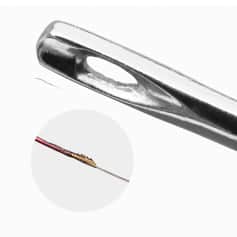Bifilar and Trifilar Coil Winding
Bifilar and Trifilar Coil Winding
Electromagnetic coils are produced by winding a conducting wire in the shape of a coil, spiral, or helix. The shape and dimensions of a coil are designed to fulfill a particular purpose. Parameters such as inductance, resistance, and strength of the desired magnetic field greatly influence the design of coil windings.
A bifilar-wound coil is one that contains two closely spaced, parallel windings. This can be achieved by winding coils using two insulated conductors.
Some bifilar-wound coils have adjacent coils in which the turns are arranged so that the potential difference is magnified (that is, the current flows in the same parallel direction). Others are wound so that the current flow is in opposite directions. In this case, the magnetic field created by one winding is therefore equal and opposite to that created by the other, resulting in a net magnetic field of zero (that is, neutralizing any negative effects in the coil). In electrical terms, this means that the self-inductance of the coil is zero.
This arrangement is used in transmission and reception magnetics of Ethernet cables and can commonly be seen in the form of a ferrite bead clamped to the outside of USB, laptop power supply, and HDMI cables.
Bifilar-wound coils are often used as a means of constructing wire-wound resistors with negligible parasitic self-inductance.
A trifilar-wound coil is created using three strands of wire spooled together.
The Challenges
Modern equipment is becoming more miniaturized which leads to a demand for micro coils. However, several challenges face the designer of modern equipment which use micro coils, particularly bifilar and trifilar wound:
- Economic mass production
- Safe production process. No risk of damaging wind isolation
- Highly reliable connections—no oxidization
- Very tight tolerances
- High quality to ensure the long life of each component
- Repeatable physical and electrical characteristics
- Robust, automated manufacturing process—eliminates human error caused by various skill levels and worker experience
These size constraints pose multiple challenges, both in the manufacturing and in the connecting of these components to each other and their support systems.
To add to these challenges, there are times when bifilar or trifilar-wound coils are needed. Having two or three conductors in your coil increases the difficulty in producing these coils at a reasonable cost and to high enough standards. Benetav’s custom winding and connecting technologies mean that we are one of the few companies in the world that can meet your micro bifilar or trifilar-wound coil requirements.
Why Choose Bifilar and Trifilar-wound Coils?
Here are some reasons why you might choose a high quality bifilar or trifilar-wound coil from Benatav for your project:
- Your device needs windings that create a current that flows in parallel directions or opposite directions.
- A bifilar-wound coil can be a better option than a wire-wound resistor.
- Your application requires a means of removing energy stored in the stray magnetic flux.
Connecting Ultra-fine Wires
To connect such fine wires, traditional, solder tin-based connections are not up to the task. Solder-based connecting creates undesired side effects, such as oxidization of the connection and the region, inferior conductivity, and low durability.
To overcome these problems, Benatav has developed a proven, cutting-edge, thermo-pressure technology to produce precise soldering with tight tolerances at very high temperatures. Our thermo-pressure bonding technology allows us to connect ultrafine wires with none of the previously mentioned drawbacks.
Using in-house engineering, Benatav has developed state-of-the-art methods and robots which allow the winding of micro coils and connecting their wires to an extent that was not possible before. These robotic technologies are not subject to the vagaries of manual production and therefore we can manufacture and connect micro coils on a scale and to standards not previously possible.
Speak to us regarding your micro coil requirements
Whatever your micro coil requirements, due to our extensive specialist experience, chances are that we have already solved any issues that may prevent us from producing your coils at highly competitive rates.
Call Benatav on +972-3-9345951 to discuss how our unique technologies can benefit your business. You can also email us at michal@benatav.co.il



